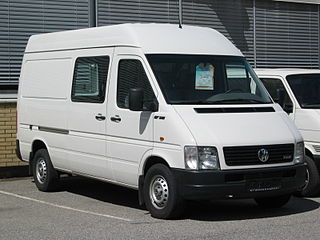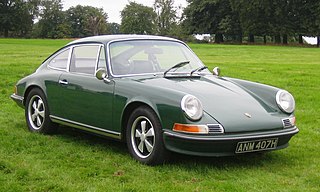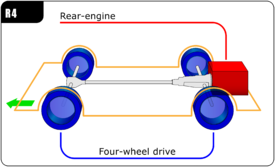
The Porsche 924 is a sports car produced by Porsche in Neckarsulm, Germany, from 1976 until 1988. A two-door, 2+2 coupé, the 924 replaced the 912E and 914 as the company's entry-level model.

The Porsche 944 is a sports car manufactured by German automobile manufacturer Porsche from 1982 until 1991. A front-engine, rear-wheel drive mid-level model based on the 924 platform, the 944 was available in coupé or cabriolet body styles, with either naturally aspirated or turbocharged engines. With over 163,000 cars produced, the 944 was the most successful sports car in Porsche's history until the introductions of the Boxster and 997 Carrera.

The Porsche 356 is a sports car that was first produced by Austrian company Porsche Konstruktionen GesmbH (1948–1949), and then by German company Dr. Ing. h. c. F. Porsche GmbH (1950–1965). It was Porsche's first production automobile. Earlier cars designed by the Austrian company include Cisitalia Grand Prix race car, the Volkswagen Beetle, and Auto Union Grand Prix cars.

The Porsche 930 is a turbocharged variant of the 911 model sports car manufactured by German automobile manufacturer Porsche between 1975 and 1989. It was the maker's top-of-the-range 911 model for its entire production duration and, at the time of its introduction, was the fastest production car available in Germany.

The Volkswagen Transporter (T4), marketed in North America as the Volkswagen EuroVan, is a van produced by the German manufacturer Volkswagen Commercial Vehicles between 1990 and 2004, succeeding the Volkswagen Type 2 (T3) and superseded by the Volkswagen Transporter (T5).

The Porsche 993 is the fourth generation of the Porsche 911 model sports car manufactured and sold between January 1994 and early 1998, replacing the 964. Its discontinuation marked the end of air-cooled 911 models.

The Porsche 996 is the fifth generation of the 911 model sports car manufactured by the German automaker Porsche from 1997 until 2006. It was replaced by the 997 in 2004, but the high performance Turbo S, GT2 and GT3 variants remained in production until 2006. The 996 had little in common with its predecessor, with the first all new chassis platform since the original 911 and a new water-cooled engine. Technically, it was a major change, a complete break from the original car other than the overall layout.

The Porsche 997 is the sixth generation of the Porsche 911 sports car manufactured and sold by the German automobile manufacturer Porsche. It was sold between 2004 and 2013. Production of the Carrera and Carrera S coupé began in early 2004, and the all-wheel drive Carrera 4 and Carrera 4S began to be delivered to customers in November 2005. Deliveries of the Turbo and GT3 derivatives were carried out in late 2006, along with the GT2 in 2007. In addition to the coupé and cabriolet versions, Targa versions of the Carrera 4 and Carrera 4S were also available, which continued the trend of the "glass canopy" roof design used since its first application in the 993 until the 991 generation. This was later reverted to the classic targa top layout used in earlier models of the 911 Targa.

The Porsche 964 is a model of the Porsche 911 sports car manufactured and sold between 1989 and 1994. Designed by Benjamin Dimson through January 1986, it featured significant styling revisions over previous 911 models, most prominently the more integrated bumpers. It was the first car to be offered with Porsche's Tiptronic automatic transmission and all wheel drive as options.

The Volkswagen LT is the largest light commercial panel van produced by Volkswagen from 1975 to 2006, before being replaced by the Crafter. Two generations were produced.

In automotive design, an RR, or rear-engine, rear-wheel-drive layout places both the engine and drive wheels at the rear of the vehicle. In contrast to the RMR layout, the center of mass of the engine is between the rear axle and the rear bumper. Although very common in transit buses and coaches due to the elimination of the drive shaft with low-floor buses, this layout has become increasingly rare in passenger cars.

A transaxle is a single mechanical device which combines the functions of an automobile's transmission, axle, and differential into one integrated assembly. It can be produced in both manual and automatic versions.

The Volkswagen Type 2 (T3) was the third generation of the Volkswagen Transporter and was marketed under various nameplates worldwide – including the Transporter or Caravelle in Europe, T25, Microbus and Kombi in South Africa/Brazil/Australia, Kampeerauto in Netherlands, Combi in France and Vanagon in North and South America.

The Porsche Panamericana is a concept automobile produced by Porsche AG. It was designed by Dutchman Harm Lagaay along with Steve Murkett (designers) and Ulrich Bez to preview some design features that would be on the upcoming 993 generation 911. It was also built as a gift for Ferry Porsche for his 80th birthday. The name comes from the famous Carrera Panamericana race that was held in the 1950s.

In automobile design, a rear-engine design layout places the engine at the rear of the vehicle. The center of gravity of the engine itself is behind the rear axle. This is not to be confused with the center of gravity of the whole vehicle, as an imbalance of such proportions would make it impossible to keep the front wheels on the ground.

The original Porsche 911 is a luxury sports car made by Porsche AG of Stuttgart, Germany. A prototype of the famous, distinctive, and durable design was shown to the public in autumn 1963. Production began in September 1964 and continued through 1989. It was succeeded by a modified version, internally referred to as Porsche 964 but still sold as Porsche 911, as are current models.
The ISO standard vehicle identification number (VIN) was introduced for the Porsche model year 1981.

The Porsche 991 is the seventh generation of the Porsche 911 sports car, which was unveiled at the 2011 Frankfurt Motor Show on 15 September as the replacement for the 997. The 991 was an entirely new platform, only the third since the original 911 launched in 1963. Production of the 991 generation ended on December 20, 2019, with 233,540 units produced.

The Porsche 911 is a two-door 2+2 high performance rear-engined sports car introduced in September 1964 by Porsche AG of Stuttgart, Germany. It has a rear-mounted flat-six engine and originally a torsion bar suspension. The car has been continuously enhanced through the years but the basic concept has remained unchanged. The engines were air-cooled until the introduction of the 996 series in 1998.

The Porsche 992 is the eighth and current generation of the Porsche 911 sports car, which was introduced at the Porsche Experience Center in Los Angeles on 27 November 2018.






























